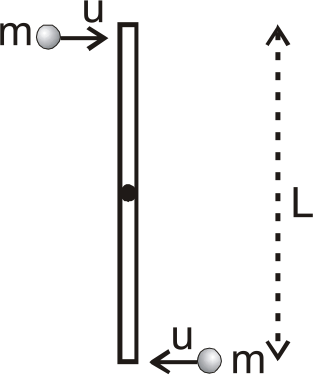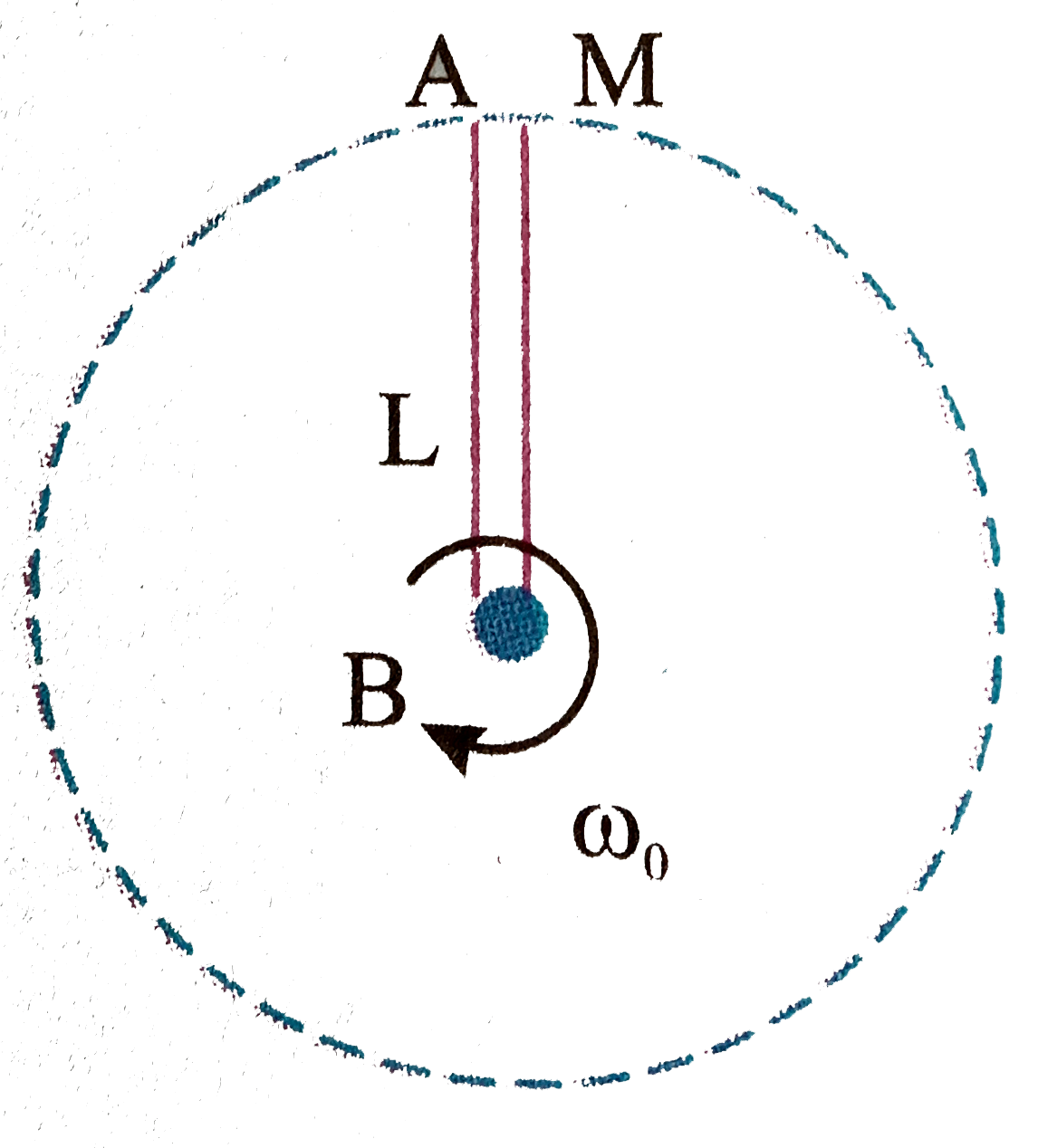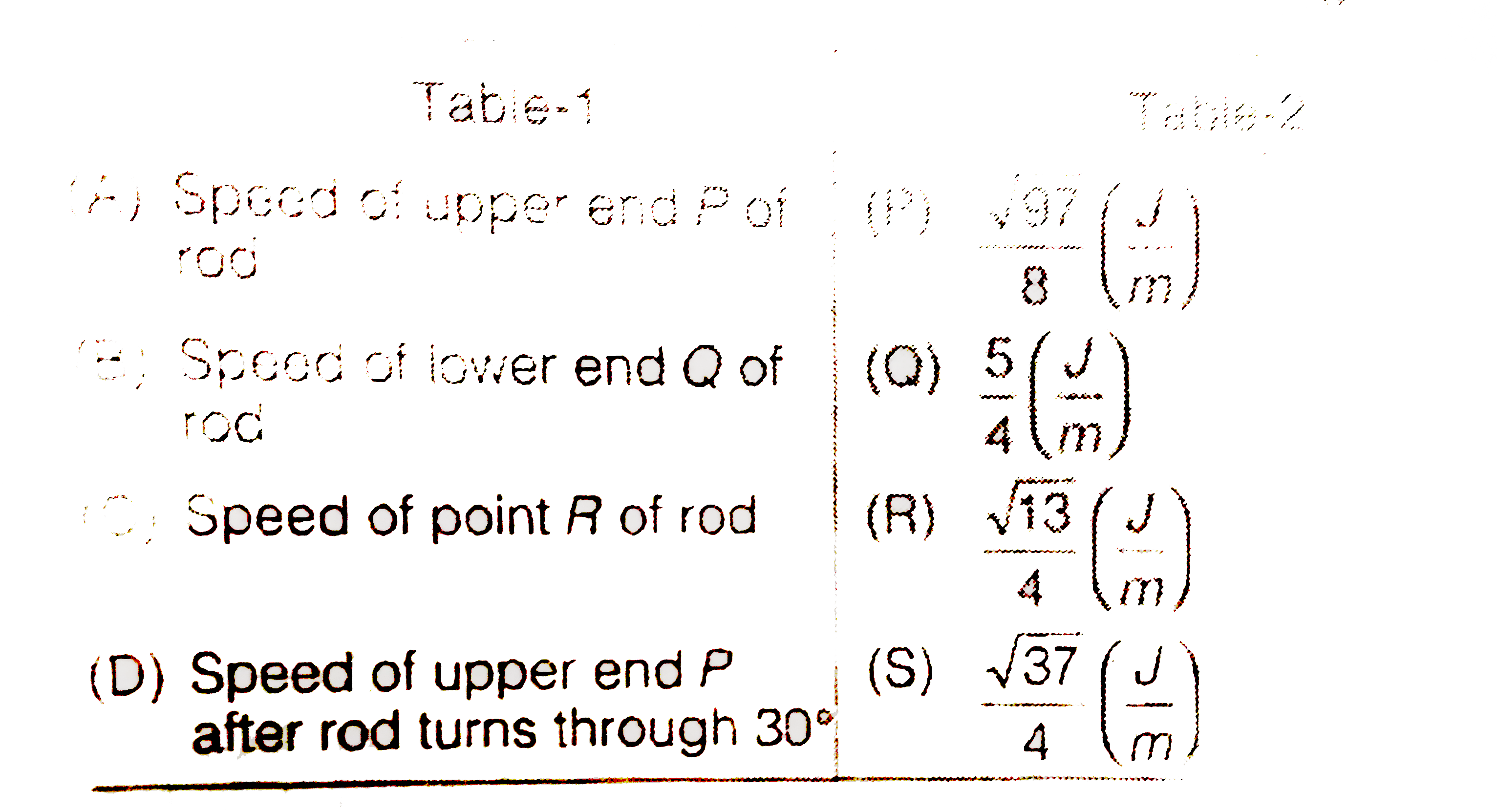A square made of 4 uniform rods each of mass m=1/14 kg and length l=1m each
is hinged about midpoint of AB as shown and is lying on a smooth horizontal table. Two forces F=154N act on the square in the direction shown. They are always perpendicular to the rods AB and AD. Find the angular velocity (in rad/s) of the square by the time it rotates by an angle of π2

ω=66rad/sec
Topper's Solved these Questions
- ROTATIONAL MECHANICSBook:AAKASH SERIESChapter:ROTATIONAL MECHANICSExercise:Numerical Exercise (LEVEL-2)
Explore 40 Videos
- ROTATIONAL DYNAMICS Book:AAKASH SERIESChapter:ROTATIONAL DYNAMICS Exercise:PRACTICE SHEET (ADVANCED) Integer Type Questions
Explore 7 Videos
- SIMPLE HARMONIC MOTION Book:AAKASH SERIESChapter:SIMPLE HARMONIC MOTION Exercise:ADDITIONAL PRACTICE EXERCISE (LEVEL - II)(PRACTICE SHEET (ADVANCED)) (INTEGER TYPE QUESTIONS)
Explore 3 Videos
Similar Questions
A solid sphere rolls down two different inclined planes of the same heights but different angles of inclination. Will it reach the bottom with the same speed in each case? Will it take longer to roll down one plane than the other? If so, which one and why?
View SolutionFour uniform solid spheres each of diameter √5 cm and mass 0.5 kg are placed with their centres at the corners of a square of side 4 cm. The moment of inertia of the system about the diagonal of the square is N×10−4kg m2, then the value of N is .
View SolutionConsider the motion of a ball in a tunnel through the earth (radius of the earth is R and mass of the earth is M), the tunnel is along a chord and the ball is released from the surface. The time period of the ball is √x (approx), find x.
View SolutionA uniform rod of mass m and length l is pivoted smoothly at O . A horizontal force acts at the bottom of the rod. a. Find the angular velocity of the rod as the function of angle of rotation theta. b.What is the maximum angular displacement of the rod?
View SolutionA composite rod comprising two rods of mass m and 2m and each of length l = 1 m as shown in the figure. Assume omega = 10 rad//s and m = 1 kg , the KE of the rotating composite rod is. .
View SolutionA uniform rod of mass 200 grams and length L = 1m is initially at rest in vertical position. The rod is hinged at centre such that it can rotate freely without friction about a fixed horizontal axis passing through its centre. Two particles of mass m = 100 grams each having horizontal velocity of equal magnitude u = 6 m/s strike the rod at top and bottom simultaneously as shown and stick to the rod. Find the angular speed (in rad/sec.) of rod when it becomes horizontal.

View SolutionA rod of mass M and length L lying horizontally is free to rotate about a vertical axis through its end. A horizontal force F on the rod at the other end, the force always remains perpendicular to the rod. Find the angular velocity of the rod when it has turned an angle pi//2 .
View SolutionA thin rod AB of mass M and length L is rotating with angular speed ω0 about vertically axis passing through its ends B on a horizontal smooth table as shown. If at some instant the hinge at end B of rod is opened then which of the following statemtents is / are correct about motion of rod?

View SolutionA uniform rod of mass M and length L is hinged at its end to a wall so that it can rotate freely in a horizontal plane. When the rod is perpendicular to the wall a constant force F starts acting at the centre of the rod in a horizontal direction perpendicular to the rod. The force remains parallel to its original direction and acts at the centre of the rod as the rod rotates. (Neglect gravity). (a) With what angular speed will the rod hit the wall ? (b) At what angle theta (see figure) the hinge force will make a 45^(@) angle with the rod ?
View SolutionA mechanism consists of a part which is translated with a velocity u and a rod AB of length L and mass M hinged at A The rod rotates about axis A with angular velocity omega the kinetic energy of rod when it is vertical as shown is
View SolutionA uniform rod of mass m and length l is lying on a smooth table. An impulse J acts on the rod momentarily as shown in figure at point R. Just after that:


View SolutionA uniform rod AB of mass m and length l is placed over two smooth conducting rails P and Q. If the witch shown as closed at t=0, find the velocity of rod AB as a function of time.
View SolutionA rod AB of mass M and length L is shown in figure. End A of rod is hinged and end B is lying on the ground. Find the Normal reaction by ground on the rod
View SolutionA rod AB of mass M and length L is shown in figure. End A of rod is hinged and end B is lying on the ground. Find the

Horizontal component of the force applied by the hinge
View SolutionA square made of 4 uniform rods each of mass m=114 kg and length l=1m each, is hinged about midpoint O of AB as shown and is lying on a smooth horizontal table. Two forces F=154 N act on the square in the direction shown. They are always perpendicular to the rods AB and AD. If the angular velocity (in rad/s) of the square by the time it rotates by an angle of π2 is (60+n), find n [Take π=227]
View SolutionA uniform rod of mass m and length l is lying on a smooth table. An impulse J acts on the rod momentarily as shown in figure at point R. Just after that:
View Solution

